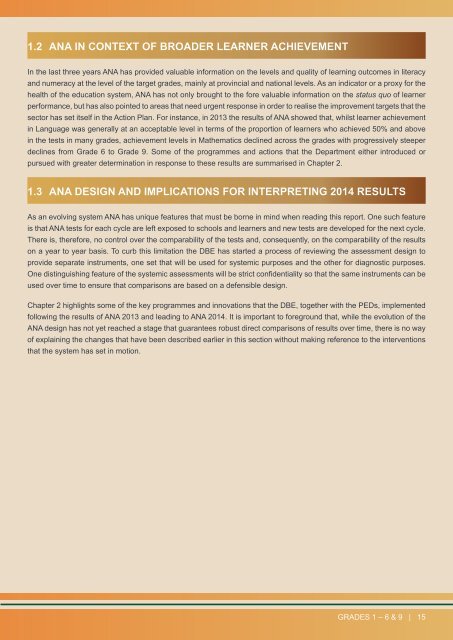1. INTRODUCTI<strong>ON</strong>The <strong>2014</strong> Annual National Assessment (<strong>ANA</strong>) is the third successful administration of national standardised assessmentin South Africa. <strong>ANA</strong> is now firmly located as an important measure to improve learner performance and thus establishitself as a corner stone of education in the General Education and Training band.Through the implementation of <strong>ANA</strong> the sector is responsive to potential risks to quality teaching and learning with agreater focus on designing interventions that are data-driven and based on credible assessment measures which areindependently verified. The data from three consecutive large-scale assessment programmes conducted in 2012, 2013and <strong>2014</strong>, involving more than 7 million learners, allows for an intensive analysis of the system from a qualitative andquantitative perspective and for an evaluation of the progress made in learner performance over the years. The <strong>ANA</strong>results provide a situated context for a better understanding of learner performance at lower levels of the system i.e.Grades 1 to 9, which serves as an early warning system of potential problems that may emerge in the Further Educationand Training band.This report outlines the policy context, the purpose and the historical evolution of <strong>ANA</strong> in the three years leading to<strong>2014</strong> as the backdrop against which the results should be read and understood. Included in the report are some of thepertinent programmes and interventions that the DBE, together with the Provincial Education Departments (PEDs), hasinitiated. The presentation of the results is preceded by a detailed account of the design and methodology that the DBEhas adopted in the administration of these tests. The results are presented graphically and in tabular format and coversthe national, provincial and district contexts.1.1 <strong>THE</strong> GROWTH <strong>OF</strong> A NATI<strong>ON</strong>AL ASSESSMENT MODELThe South African national assessment model is gradually evolving due to lessons learned from preceding years. Theresponse of Government to low, but improving, achievement levels in cross-national and regional studies such asthe Southern and Eastern Consortium for Monitoring Educational Quality (SACMEQ) and the Trends in InternationalMathematics and Science Study (TIMSS), has been to conduct regular national assessments at key stages. Since thedemocratic transition in 1994, the Ministry of Education has made use of two types of national assessments to reportthe results of learner performance. Following on the designs of the cross-national and regional studies, the first typeinvolved systemic evaluations (SE) conducted on a 5-year cycle on random samples of public schools at either Grade3, 6 or 9. The results were used to report on the policy goals of access, equity and quality as indicators of the ‘health’ ofthe education system.The second type of national assessment, <strong>ANA</strong>, is based on a similar framework to the previously conducted systemicevaluations, but targets a more diagnostic interpretation of learner achievement. The design of <strong>ANA</strong> broke new ground inprimary school assessment in South Africa by embarking on a census type of external assessment involving all learnersin all public schools. South Africa is one of the few countries that has adopted a census model of national assessment.In <strong>2014</strong> all grades in the General Education and Training Band were assessed. Within the context of a long-term sectorplan, such as the Action Plan <strong>2014</strong>, the <strong>ANA</strong> is premised on providing valuable data to planners in Government, theBasic Education Ministry, social partners and various institutional role players to improve the quality of basic education.14 | <strong>REPORT</strong> <strong>ON</strong> <strong>THE</strong> ANNUAL NATI<strong>ON</strong>AL ASSESSMENTS <strong>OF</strong> <strong>2014</strong>
1.2 <strong>ANA</strong> IN C<strong>ON</strong>TEXT <strong>OF</strong> BROADER LEARNER ACHIEVEMENTIn the last three years <strong>ANA</strong> has provided valuable information on the levels and quality of learning outcomes in literacyand numeracy at the level of the target grades, mainly at provincial and national levels. As an indicator or a proxy for thehealth of the education system, <strong>ANA</strong> has not only brought to the fore valuable information on the status quo of learnerperformance, but has also pointed to areas that need urgent response in order to realise the improvement targets that thesector has set itself in the Action Plan. For instance, in 2013 the results of <strong>ANA</strong> showed that, whilst learner achievementin Language was generally at an acceptable level in terms of the proportion of learners who achieved 50% and abovein the tests in many grades, achievement levels in Mathematics declined across the grades with progressively steeperdeclines from Grade 6 to Grade 9. Some of the programmes and actions that the Department either introduced orpursued with greater determination in response to these results are summarised in Chapter 2.1.3 <strong>ANA</strong> DESIGN AND IMPLICATI<strong>ON</strong>S FOR INTERPRETING <strong>2014</strong> RESULTSAs an evolving system <strong>ANA</strong> has unique features that must be borne in mind when reading this report. One such featureis that <strong>ANA</strong> tests for each cycle are left exposed to schools and learners and new tests are developed for the next cycle.There is, therefore, no control over the comparability of the tests and, consequently, on the comparability of the resultson a year to year basis. To curb this limitation the DBE has started a process of reviewing the assessment design toprovide separate instruments, one set that will be used for systemic purposes and the other for diagnostic purposes.One distinguishing feature of the systemic assessments will be strict confidentiality so that the same instruments can beused over time to ensure that comparisons are based on a defensible design.Chapter 2 highlights some of the key programmes and innovations that the DBE, together with the PEDs, implementedfollowing the results of <strong>ANA</strong> 2013 and leading to <strong>ANA</strong> <strong>2014</strong>. It is important to foreground that, while the evolution of the<strong>ANA</strong> design has not yet reached a stage that guarantees robust direct comparisons of results over time, there is no wayof explaining the changes that have been described earlier in this section without making reference to the interventionsthat the system has set in motion.GRADES 1 – 6 & 9 | 15


